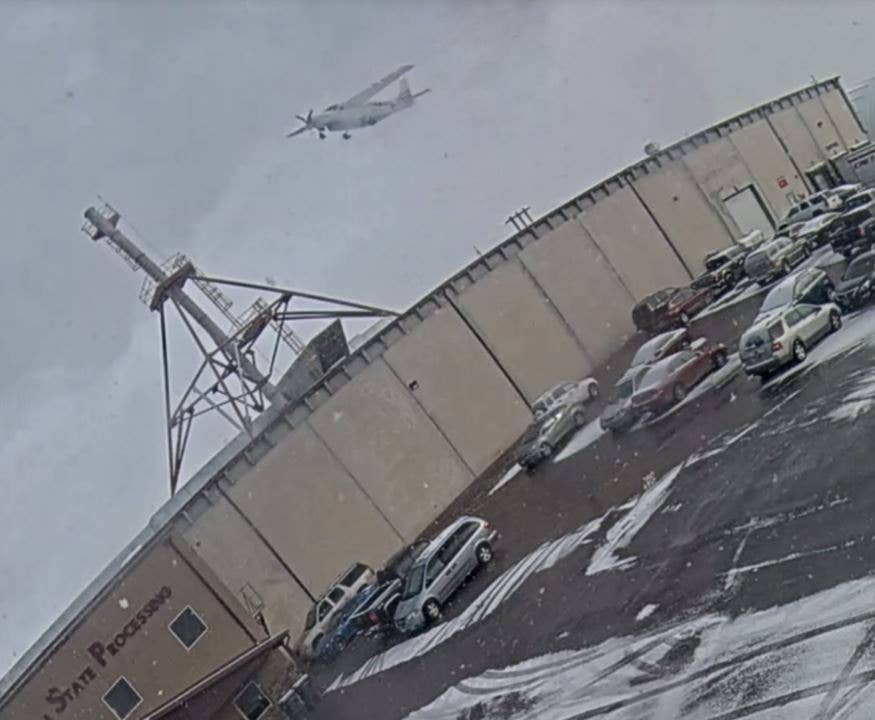NTSB: Pilot Was Flying Too Low Before Hitting Smokestack in Idaho
The potato processing plant also had not correctly painted the hazards to increase their visibility, the aviation safety agency said.

A security camera captured this image of the Cessna Caravan moments prior to the 2022 accident. [Courtesy: National Transportation Safety Board]
Mitigation measures addressing the hazards of an exhaust stack on the roof of a potato processing plant were supposed to be in place in Idaho prior to a Cessna 208 Caravan flying into them, according to the National Transportation Safety Board (NTSB).
The NTSB released its final report into the fatal April 2022 accident that occurred when the pilot was on approach to Burley Municipal Airport (KBYI). The aircraft collided with an exhaust stack that lies directly beneath the extended centerline of Runway 20. The accident happened shortly after 8:30 a.m. when it was snowing and IFR conditions prevailed.
According to the NTSB, the aircraft struck an agglomerate stack that measured 32 inches in diameter. Just beyond it was a group of six exhaust stacks. The smokestack, which is used to collect particulate emissions from the manufacturing process, is 100 feet above ground level.
According to the 24-page NTSB report, the FAA had been advised of the stacks as a potential hazard to aircraft in 2016 and had been working with the plant owner on mitigation measures. Those measures included decommissioning of the airport's visual approach slope indicator (VASI), painting the exhaust stacks white and aviation orange to make them more visible, and adding an obstruction lighting on the tallest stack.
However, photographs of the stacks provided to the NTSB reveal no such paint scheme.
In its 24-page final report, NTSB said its investigators, who did not travel to the accident site, could not determine if the obstruction light on the tallest exhaust stack was functioning at the time of the accident, as it was allegedly stolen from the scene by an individual who was not part of the official instigation.
According to the NTSB report, this individual later appeared in a YouTube video with the light and discussed its use during the accident sequence. The video was shot in the individual's home office several states away.
The local police department investigated the theft, which included reviewing the YouTube video. A copy of the YouTube video has been included in the public documents of the NTSB report. The NTSB states the YouTube individual later recanted his statements, saying the light he appeared on camera with was not the one from the crash site.
Accident Details
At the time of the accident, the Caravan pilot held a commercial certificate, had approximately 1,400 hours total time, and had been flying for less than six months for Gem Air LLC. As is protocol during an accident investigation, the NTSB reviewed the company's training procedures.
According to the chief pilot of Gem Air, the company's pilots were taught to use the Garmin vertical flight path indicator as an "advisory guidance" and to use the autopilot on nonprecision approaches both in VNAV and Approach mode.
Company flight records indicated the pilot had flown to KBYI at least 12 times before the accident.
The accident happened as the pilot was attempting to fly the RNAV 20 approach, which takes the aircraft directly over the potato processing plant with numerous vent stacks constantly in operation.
The standard for airspeed after passing the final approach fix was 120 kias indicated, according to the Flight Maneuvers Description Manual (FMDM).
The FMDM also stated that "after passing the final approach fix inbound, begin descent to MDA or step-down fix, if applicable. Descent should be approximately 1,000 fpm [feet per minute] to ensure that you are at the next required altitude. Failure to make the descent to MDA in a timely manner may result in missing the opportunity to visually identify the airport in time to continue a normal descent to landing.”
The standard approach gradient for an instrument approach is 3.0 degrees. The approach plate for the RNAV 20 at KBYI notes the descent angle for the approach is 3.75 degrees. Pilots are taught that an approach gradient of more than 3.0 degrees is a good indication that there is an obstacle to avoid on the approach path. The Chart Supplement Directory for the airport noted this, using “stack” in the airport descriptor.
The steep gradient is also noted on the RNAV 20 approach plate.
The Aeronautical Information Manual warns pilots about the dangers of exhaust plumes both visible and invisible, as they can contribute to turbulence, wind shear, and reduced visibility. Pilots are advised to avoid flying over them.
Failure to Maintain Altitude
A security camera photograph showed the Caravan in a slightly nose-up attitude as it passed over the plant. A witness on the ground told NTSB investigators that the sound of the aircraft engine increased just moments before it collided with the exhaust stack.
The pilot failed to maintain altitude during an instrument approach, "which resulted in a descent below the approach path and impact with a vent stack," the NTSB said in its conclusion determining the probable cause of the accident. "Also causal was the failure of the processing plant to correctly paint the vent stacks, which had been determined by the FAA to be a hazard to navigation due to their proximity to the landing approach path. Contributing to the accident was the likely distraction/illusion/obscuration created by steam from the processing plant, which intermittently obscured the runway."

Sign-up for newsletters & special offers!
Get the latest FLYING stories & special offers delivered directly to your inbox






